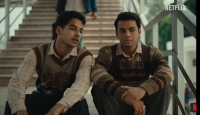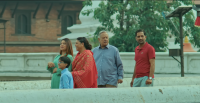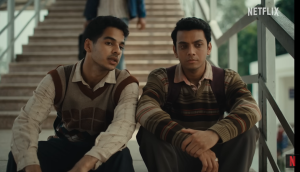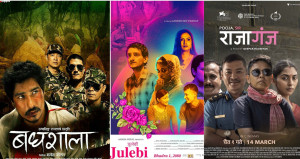Movies
‘RRR’, a romantic love story between two macho men
The already superhit movie has all the tropes of romance movies.
Abhimanyu Dixit
(Editor’s note: The review contains some spoilers of the film RRR and Kuch Kuch Hota Hai.)
Remember “Katappa ne Bahubali ko kyu maara?'' (Why did Katappa kill Bahubali?). ‘Bahubali: The Beginning’, the biggest commercial hit of Indian cinema at the time, concluded with a cliffhanger. The movie’s titular character (Prabhas) was killed by his confidante Katappa (Satyaraj) without any plausible reason.
Instead of waiting for two full years for the movie’s second instalment to find the reason behind Kattapa killing Bahubali, audiences took ownership of the film and came up with their own answers, which varied from philosophical, political, religious, logical to absurd.
This phenomenon of audiences taking ownership of a text and engaging with it was explained by cultural and literary theorist Roland Barthes in ‘The Death of the Author’, published in 1967. The essay talks about how an author’s authority over their artworks dies the moment they are made public, allowing readers the freedom to interpret the artworks in ways they deem fit. When a media text becomes popular, the author’s intention ceases to matter. The author will instead be absorbed into the text, which will then be interpreted by the general public in various unique ways and forms. In the example above, the audiences engaged with Kattapa’s murder of Bahubali in Reddit forums, on Twitter, made memes, and YouTube videos on it.
Rajamouli’s latest ‘RRR: Rise Roar Revolt’ is already a super hit. Now that the makers of RRR have already made their work public, it is upto us, the audience, to interpret and question the film in ways that we deem fit with our knowledge of existing cultural codes. Since I do not have prior knowledge of Indian freedom fighters, I choose to decipher the movie by relying on my cinema experience. Based on that and using my understanding of ‘Death of the Author’, I read RRR as a romance film between two macho men.
RRR is set in India of the 1920s. Malli (Twinkle Sharma), a young tribal girl, is kidnapped by evil colonel Scott (Ray Stevenson) and his wife Catherine (Alison Doody). Coming to rescue Malli is her elder brother Bheema (Junior NTR ), who is introduced as a macho man brave enough to capture a tiger alive.
Elsewhere, Ram Raju (Ram Charan) is an officer with the British Raj. His introduction scene shows him fighting thousands of angry protestors, and against all odds, he successfully apprehends a culprit.
The evil colonialists get wind of Bheema’s plans to rescue Malli. So, colonel Scott issues a challenge: If anyone can capture Bheema alive, they will be promoted to special forces. Ram Raju volunteers!
The film takes around 30 minutes to establish the heroism of our male leads- Bheema and Ram Raju, giving them clearly defined goals. So far, we’ve seen both of them shirtless and flaunting their muscular bodies. We know we will only root for these two over three hours. So, like many romantic movies, after the film sets up the two leads, we wait for a ‘meet-cute’.
In their study of romantic comedies, Vanity Fair defines meet-cute as a ‘serendipitous meeting’ between the two main leads. Two people meet each other by chance and find themselves irresistible. In ‘RRR’, right before their meet-cute, Ram Raju is on a viaduct above the Yamuna River, and Bheema is by the river shore.
They meet serendipitously when a train on the viaduct catches fire, and a young boy approaches certain death. Ram Raju gets on top of the bridge and signals to Bheema, who is almost a mile away. Bheema not only sees Ram Raju but also clearly understands the strategy to save the boy, and they manage to do just that. Both then celebrate their win by holding hands.
The movie immediately breaks for a song, ‘Dosti,’ where the heroes find each other irresistible. They hold hands, carry each other on their shoulders, and display other censor-approved forms of appreciation. Their mutual appreciation is more evident in another song—the famous duet ‘Naacho’, sung by Vishal Mishra and Rahul Sipligunj. In the song, both leads team up to out-dance the snobs of the British Raj.
Junior NTR and Ram Charan are superstars in the Telugu cinema industry. Both have heralded many films as the only leads. However, when they share the screen, there is no competition or feeling of rivalry. You will see genuine respect, chemistry, and love for each other, especially in the song 'Naacho'.
Vanity Fair studied 79 romantic films from Hollywood and presented that 31 percent of relationships began with some form of deception. This is a staple trope of romance films, even in Indian cinema. Both Ram Raju and Bheema also begin their relationship under false pretence. Both do not know the other’s true identity. Both fall in love with each other, and one even saves the other’s life. However, when both realise they are on opposite sides, they break up.
I do not read this film as a friendship story partly because both Ram Raju and Bheema’s heterosexual love interests are not fully formed. Male friendship films from Indian cinema in the past spend time developing their heterosexual love interests, like in Sholay (1975), where Jay (Amitabh Bacchan) and Veeru (Dharmendra) fall in love with Radha (Jaya Bachchan) and Basanti (Hema Malini), respectively. In RRR, Bheema is pursued by Jennifer (Olivia Morris), and Ram Raju is betrothed to Seetha (Alia Bhatt). While Jennifer’s only job is to be awed by Bheema, Seetha has a more important role in the plot. She inspires Bheema to unite with Ram Raju.
At the end of his films, Rajamouli uses a stamp of approval of his name, declaring that everything we witnessed was intentional and meticulously designed by him—he is the auteur. Barthes, in his essay, defines the auteur as not someone who comes up with original ideas but instead as a collage maker who pieces together pre-existing ideas uniquely and originally. In his execution of RRR, Rajamouli does just that—he also pieces the film through pre-existing imagery from nature, religion, and history, among other texts.
Rajamouli introduces Ram Raju as fire and Bheema as water. Later, he turns them into religious avatars of Ram and Bheem armed with their respective weapons—bow and arrow and a spear. Rajamouli’s cinematographer, KK Senthil Kumar, captures multiple images referencing ‘Ramayan’ and ‘Mahabharat’. This imagery is also supported by MM Keeravani’s music, which incorporates Sanskrit verses.
Before the film’s climax, I wasn’t sure about presenting the film as a love story between two men in my review. Until the climax, the film’s screenplay mainly builds up to long staged set pieces where we cheer for the physical prowess of these two macho men. However, in the climax, I witnessed another staple trope of a romance film that sealed my beliefs—the grand romantic gesture.
In most romance films, one of the leads performs a romantic gesture, where they confess their admiration. This is usually a climax in romance films—think ‘Kuch Kuch Hota Hai’ (1998), where Rahul (Shahrukh Khan) arrives in the nick of time to stop Anjali (Kajol) from marrying Aman (Salman Khan). Before this, Anjali felt trapped by her obligations. Similarly, in ‘RRR’s climax, Ram Raju is imprisoned by the evil British Raj. Bheema decides to perform his grand romantic gesture and infiltrate the heavily guarded prison to confess his admiration.
And, I was convinced.
Bheema saves Ram Raju, and the moment they unite, I, along with the movie-goers present in the hall, cheer. The cheering continued as two macho men united by love destroyed the British Raj.
That’s my reading, take it or leave it, because now the death of the author happens.




 8.12°C Kathmandu
8.12°C Kathmandu














